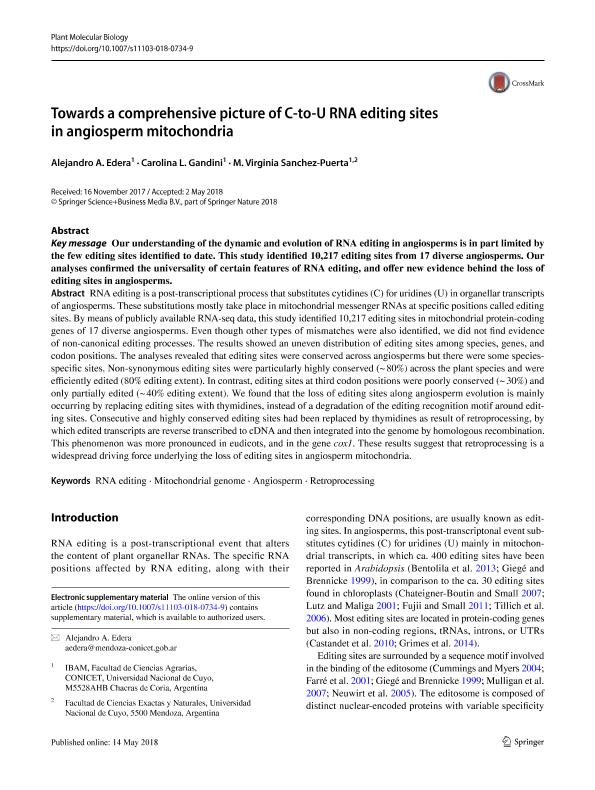Mostrar el registro sencillo del ítem
dc.contributor.author
Edera, Alejandro

dc.contributor.author
Gandini, Carolina Lia

dc.contributor.author
Sánchez Puerta, María Virginia

dc.date.available
2019-11-12T20:03:17Z
dc.date.issued
2018-06
dc.identifier.citation
Edera, Alejandro; Gandini, Carolina Lia; Sánchez Puerta, María Virginia; Towards a comprehensive picture of C-to-U RNA editing sites in angiosperm mitochondria; Springer; Plant Molecular Biology; 97; 3; 6-2018; 215-231
dc.identifier.issn
0167-4412
dc.identifier.uri
http://hdl.handle.net/11336/88685
dc.description.abstract
Key message: Our understanding of the dynamic and evolution of RNA editing in angiosperms is in part limited by the few editing sites identified to date. This study identified 10,217 editing sites from 17 diverse angiosperms. Our analyses confirmed the universality of certain features of RNA editing, and offer new evidence behind the loss of editing sites in angiosperms. Abstract: RNA editing is a post-transcriptional process that substitutes cytidines (C) for uridines (U) in organellar transcripts of angiosperms. These substitutions mostly take place in mitochondrial messenger RNAs at specific positions called editing sites. By means of publicly available RNA-seq data, this study identified 10,217 editing sites in mitochondrial protein-coding genes of 17 diverse angiosperms. Even though other types of mismatches were also identified, we did not find evidence of non-canonical editing processes. The results showed an uneven distribution of editing sites among species, genes, and codon positions. The analyses revealed that editing sites were conserved across angiosperms but there were some species-specific sites. Non-synonymous editing sites were particularly highly conserved (~ 80%) across the plant species and were efficiently edited (80% editing extent). In contrast, editing sites at third codon positions were poorly conserved (~ 30%) and only partially edited (~ 40% editing extent). We found that the loss of editing sites along angiosperm evolution is mainly occurring by replacing editing sites with thymidines, instead of a degradation of the editing recognition motif around editing sites. Consecutive and highly conserved editing sites had been replaced by thymidines as result of retroprocessing, by which edited transcripts are reverse transcribed to cDNA and then integrated into the genome by homologous recombination. This phenomenon was more pronounced in eudicots, and in the gene cox1. These results suggest that retroprocessing is a widespread driving force underlying the loss of editing sites in angiosperm mitochondria.
dc.format
application/pdf
dc.language.iso
eng
dc.publisher
Springer

dc.rights
info:eu-repo/semantics/openAccess
dc.rights.uri
https://creativecommons.org/licenses/by-nc-sa/2.5/ar/
dc.subject
ANGIOSPERM
dc.subject
MITOCHONDRIAL GENOME
dc.subject
RETROPROCESSING
dc.subject
RNA EDITING
dc.subject.classification
Bioquímica y Biología Molecular

dc.subject.classification
Ciencias Biológicas

dc.subject.classification
CIENCIAS NATURALES Y EXACTAS

dc.title
Towards a comprehensive picture of C-to-U RNA editing sites in angiosperm mitochondria
dc.type
info:eu-repo/semantics/article
dc.type
info:ar-repo/semantics/artículo
dc.type
info:eu-repo/semantics/publishedVersion
dc.date.updated
2019-10-15T14:10:20Z
dc.identifier.eissn
1573-5028
dc.journal.volume
97
dc.journal.number
3
dc.journal.pagination
215-231
dc.journal.pais
Alemania

dc.journal.ciudad
Berlin
dc.description.fil
Fil: Edera, Alejandro. Consejo Nacional de Investigaciones Científicas y Técnicas. Centro Científico Tecnológico Conicet - Mendoza. Instituto de Biología Agrícola de Mendoza. Universidad Nacional de Cuyo. Facultad de Ciencias Agrarias. Instituto de Biología Agrícola de Mendoza; Argentina
dc.description.fil
Fil: Gandini, Carolina Lia. Consejo Nacional de Investigaciones Científicas y Técnicas. Centro Científico Tecnológico Conicet - Mendoza. Instituto de Biología Agrícola de Mendoza. Universidad Nacional de Cuyo. Facultad de Ciencias Agrarias. Instituto de Biología Agrícola de Mendoza; Argentina
dc.description.fil
Fil: Sánchez Puerta, María Virginia. Consejo Nacional de Investigaciones Científicas y Técnicas. Centro Científico Tecnológico Conicet - Mendoza. Instituto de Biología Agrícola de Mendoza. Universidad Nacional de Cuyo. Facultad de Ciencias Agrarias. Instituto de Biología Agrícola de Mendoza; Argentina
dc.journal.title
Plant Molecular Biology

dc.relation.alternativeid
info:eu-repo/semantics/altIdentifier/doi/https://doi.org/10.1007/s11103-018-0734-9
dc.relation.alternativeid
info:eu-repo/semantics/altIdentifier/url/https://link.springer.com/article/10.1007%2Fs11103-018-0734-9
Archivos asociados
